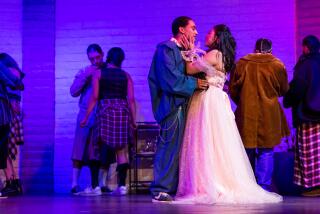Gypsy Caravan Still Gets Good Mileage
- Share via
It’s a complicated proposition, to be at once admired and unpopular. But if you’re a Gypsy musician from Europe, maybe you get used to it. Certainly singer Esma Redzepova seems undaunted.
Redzepova, whose band comes from Macedonia to the Cerritos Center for the Performing Arts on Thursday as part of the Gypsy Caravan 2 tour, has been performing for more than four decades. Over her career, she has seen a dramatic rise in global appreciation for the history and musical traditions of the Gypsies (who usually prefer to call themselves Roma), from the CD sales of the Gipsy Kings to the growing crowds that turn out for traditional music programs such as the current 15-city, four-group tour.
But at the same time, Redzepova and her fellow performers have seen Roma communities struggle throughout Europe, dogged as in centuries past by poverty, illiteracy, crime and discrimination. In her 1995 volume “Bury Me Standing: The Gypsies and Their Journey,” author Isabel Fonseca links the term “Roma” to the Sanskrit term “doma,” which means “man of low caste living by singing and music.”
Many circumstances have improved for Roma since World War II--when they came right after the Jews on the Nazis’ list of targeted peoples--but since the unraveling of communism a decade ago, many Roma in Eastern Europe have reported rising discrimination and violence against them.
In September 2000, the United Nations Committee on the Elimination of Racial Discrimination called the estimated 10 million Roma on the continent “Europe’s most persecuted minority.” In August, Roma unemployment in the Czech Republic was estimated at 70%, seven times the nation’s overall rate. The human rights association Greek Helsinki Monitor reports that since July, some 3,000 tent-dwelling Roma have been evicted from their settlements outside Athens to make way for the 2004 Olympic Games preparations. Yet throughout the continent, Roma wedding bands get steady bookings and music festivals flourish, including one each fall in Lanciano, Italy, and a large gathering each May in Saintes-Mairies-de-la-Mer in the south of France.
Redzepova’s response to all this, apart from leading her young musicians on an international touring schedule that’s expected to include 167 gigs this year, is to throw her emphasis on the upbeat.
“In Macedonia, the conditions are very nice for Gypsies, almost the same as for Macedonians,” said Redzepova a few days ago, relying on her keyboard player, Elvis Huna, for Macedonian-English translation.
“In other parts of Europe,” she continued, Roma “still have bad conditions, and not so good life.” In fact, she said, “it’s very important to go on tour in Europe, and everywhere in the world, because you can show that the culture of Gypsies is not bad, like they think. With songs, you can connect the people.”
The audiences are biggest for her music in Europe, she said, but “the door is open now” in the U.S. And Roma music is not without its blood relatives here: The U.S. Roma population is estimated at 1 million.
The Gypsy Caravan show is at once an international revue and an overview of the Roma’s long journey: The bill opens with Maharaja, a troupe of musicians and dancers from Rajasthan, India, where historians now believe the world’s scattered Roma populations originated. Maharaja’s players use such instruments as the dholak (a two-headed drum) and the sarangi (a bowed string instrument).
Redzepova and her Ensemble Teodosievski take the stage next with their trumpet, accordion and clarinet, among other instruments. Since 1976, when she was crowned at a World Romani Congress in India, she has treasured the title “Queen of the Gypsies.” Many of her songs are written in celebration or lament of workaday life and Roma traditions, including such practices as arranged marriages, one of many restrictive Roma customs that get overlooked in the standard stereotype of the footloose, fancy-free Gypsy.
Redzepova, who moved away from her Muslim parents as a teenager and married a non-Muslim of her own choosing, has rebelled against plenty of traditions in her time. After their marriage in 1968, Redzepova and husband Stevo Teodosievski, who died in 1997, took in more than 40 boys, many of them Roma orphans, and trained them, along with other young students, in traditional Balkan music. Several of them now stand beside her on stage.
Accordionist Simeon Atanasov, now the band’s chief musical arranger, has been with Redzepova since he was 5. Trumpet player Zahir Ramadanov was recruited into music school at age 8. Elvis Huna (who was born in 1977, the year of Elvis Presley’s death) joined the band recently.
Redzepova, who attributes her own endurance to abstention from alcohol and cigarettes, estimates that she’s given 12,000 public performances since her first in 1957, at age 11. She continues to live in Skopje, the Macedonian capital.
Redzepova’s ensemble is followed on the Caravan bill by Fanfare Ciocarlia, a 10-man Romanian brass band, and the Antonio El Pipa Flamenco Ensemble, which explores the interaction of Roma and southern Spanish influences that yielded flamenco. The finale is “Maharaja Flamenco,” attempt to fuse Roma origins and later adaptations, while mingling performers from the bill’s first and last acts.
The first Gypsy Caravan tour, in 1999, featured the same Rajasthani group (then known as Musafir) and the same Spanish flamenco ensemble, but the middle of the bill included Romanian, Russian and Hungarian performers. Reviewing that tour’s Orange County and Los Angeles stops for The Times, critic Chris Pasles called the program “one revelation after another,” citing high energy and artistry, as well as intriguing rhythmic and vocal similarities among performers who represent musical branches separated for centuries from their common roots.
George Cruze, road manager for that first caravan and this one, recalled that in 1999, it often seemed that “there were 45 people speaking nine different languages, and none of them was English.” Also, he said, “they just carried their accordions onto the plane, playing. They were very charming. But now we’ve got a brass band, and they’re carrying tubas around in canvas bags.” When it comes time to leave the bus behind and board a plane to reach some of their later performances on the tour, said Cruze, “that’s literally not going to fly.” (Eventually, the caseless tuba crisis was solved.)
Redzepova, of course, leaves others to worry about such details. Perhaps remembering earlier days, she had only praise for the Days Inn at Niagara Falls, the Hampton Inn near Springfield, Conn., the amenities aboard the tour bus, and responsiveness of the listeners. Maybe they turn out in smaller numbers in some stops, and maybe the Roma’s history and traditions are less known in this country than in others, she said, but once the music starts, “there is not any difference in the audiences.”
*
Gypsy Caravan 2 and 8 p.m., Thursday, at Cerritos Center for the Performing Arts, 12700 Center Court Drive, Cerritos. $25-$35. (800) 300-4345 or (562) 916-8500
More to Read
Sign up for Essential California
The most important California stories and recommendations in your inbox every morning.
You may occasionally receive promotional content from the Los Angeles Times.











